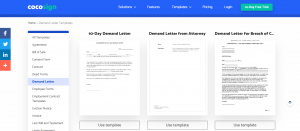You’ve decided to file a minor lawsuit. You’ve heard it’s pretty easy and painless. However, you quickly realize that you have no idea where to begin. A demand letter is essential for getting your dispute started and into the small claims courtroom.
A demand letter is a formal letter written to compel another person to take a specific action. For example, they’re generally written to ask for money from someone or something or ask for your down payment back from your lender.
They can, however, be composed for any reason. Several countries allow you to deliver a demand letter to your opponent before going to court. At this point, hiring an attorney usually is unnecessary, and you can write a demand letter on your own. To write one, collect the required papers, draft the message, and send it to the other party.
What Is a Demand Letter?
A demand letter is written at the start of the legal process in which a case is brought to court. Plaintiffs write demand letters to state the defendant’s wrongdoing, the relief sought by the defendant, and their intention to take the case to court.

Check these demand letter templates here and also download CocoSign’s demand letter templates in a ready-to-fill manner, or edit it depending on your needs. CocoSign also has a variety of other arrangements, deals, and type models.
While an attorney usually writes a demand letter, you can do it yourself in a few situations:
- If you want to sue anyone in small claims court, follow these steps.
- If you have a relatively straightforward legal problem and want to handle it without the help of an attorney,
- If you’d like to express your feelings about what happened and what you want,
- If you want to save time (and money) by writing the letter yourself and then having your attorney review and edit it, go ahead and do so.
Tips for Writing a Demand Letter
Until filing a lawsuit, acknowledge the Demand Letter.
Presenting a demand letter to the other entity as a form to initiate a conversation is one way to prevent expensive and time-consuming litigation.

Unlike the other template providers, CocoSign has put a lot of effort into making this demand letter template suitable. Demand letter templates can be downloaded from their page. Read more here about demand letters here on CocoSign.
Summarize at the Beginning
This move is close to a business plan’s executive summary. Say the key argument you want to make about the harm done in a sentence or two, then make your case for reimbursement or other damages. Writing the description allows you to condense your point to the essentials and informs your reader about the letter’s purpose right away.
Have The Reader in Mind
Write your demand letter as if it were addressed to the person who will be reading it. Attorneys also use “legalese,” which can be perplexing and anxiety-inducing. You may use standard business words if your reader is a businessperson. Make use of your common sense and write to express yourself clearly.
Professionalism is important.
Don’t be rude to the other side or call them names. Leave your personal feelings out of the descriptions and be direct and calm. When writing down the facts of your situation, “take the high road.” Call the defendant “Mr.[last name]” or “the defendant.” You can say that if you’re mad, but being angry won’t get you anywhere. It will support your case if you are straightforward, direct, and competent.
Be Complete and Detailed
From the beginning, tell the tale of what happened. Dates, numbers, and dollar amounts should all be included. If you can provide details about letters you received, when invoices were sent, and how they were sent, a small claims court judge reading your demand letter is more likely to lend you money. If you paid someone to do work for you and didn’t finish it, you’ll need to prove it.
Be Reasonable
Make the demands as far as possible when you get to the section of the demand letter where you state them. It can be challenging to measure the damages you seek; for example, “pain and suffering” is usually decided by a jury. The following are examples of damages:
- Real damages that can be measured and general damages that can’t be determined precisely, such as pain and suffering and loss of potential profits, are examples of compensatory damages.
- Punitive damages are awarded for deliberate injury.
Ascertain that the letter has been sent.
If you’re dealing with an attorney, they’ll deliver the demand letter on your behalf. However, you may want to get a verification of acceptance from the post office if you’re sending it yourself before the litigation starts. You may also pay the court to personally deliver the letter and have the recipient sign that it was sent.
